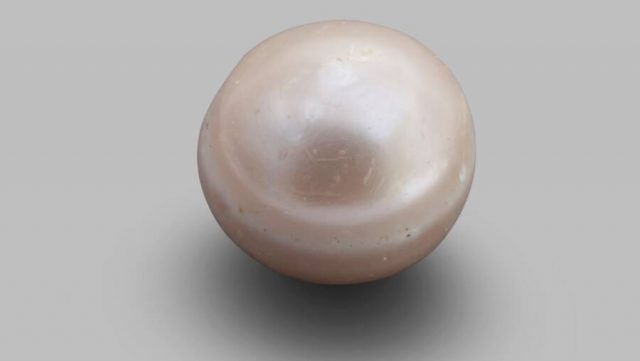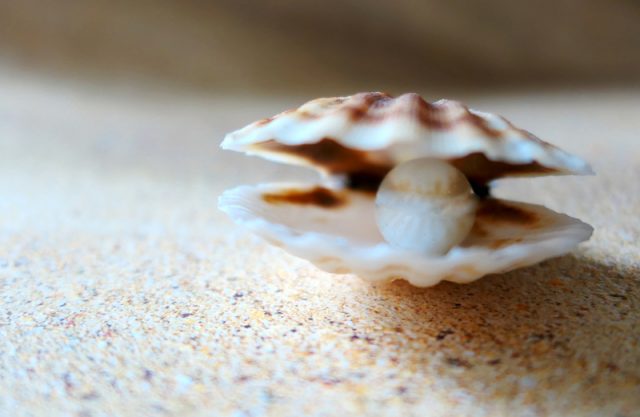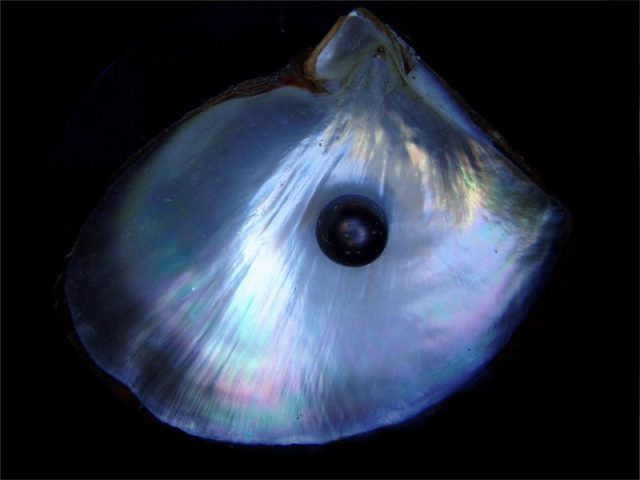The Louvre Abu Dhabi Museum in the United Arab Emirates is exhibiting the world’s oldest natural saltwater pearl found to date. The exhibit, “10,000 Years of Luxury,” opened on October 30, 2019.
The unusual pearl, pink in color, was found at an archaeology dig on Marawah Island, off the coast of Abu Dhabi, according to the Department of Culture and Tourism of the United Arab Emirates on cnn.com. The world’s oldest pearl, which was discovered in 2017, was radio carbon tested to about eight thousand years ago. At about .13 of an inch, experts believe it is proof of pearl trading as far back as Neolithic times.
According to abudhabiculture.ae, pearls were a great source of wealth for the United Arab Emirates from about the 1880s to about 1920. Pearl diving expeditions, Ghous Al Kabir (The Big Dive), took place in the summer lasting for about four months.

The boats would sail the shallow oyster beds of the Arabian Gulf from June to September after the Hiraat ceremony was completed in which the members of the community would stand on the beach to sing and watch as the pearl divers set out to sea. The captain of the fleet would then announce the beginning of pearl diving season. When the boats came home in September the people of the town would decorate their homes and prepare a feast for the tired sailors.
Most of the boats held about thirty men but often young boys referred to as Ridha would join the sailors as servants and helped with shelling the oysters and each ship had a Naham to entertain the men with songs and stories. The divers frequently held their noses closed with an Al Fettam, a clip made of shell or bone and carried a woven bag around his neck to hold the oysters called an Al Dean.
The oldest known natural pearl in the world has been discovered by DCT archaeologists working at a Neolithic site on Marawah Island. The 8,000-year-old ‘Abu Dhabi Pearl’ will feature in the upcoming @louvreabudhabi exhibition 10,000 Years of Luxury pic.twitter.com/Kd3jHHCVCT
— Department of Culture and Tourism – Abu Dhabi (@dctabudhabi) October 20, 2019
The pearling industry was changed dramatically when oysters were driven nearly to the point of extinction as pearl hunters simply forced open living oysters to find a pearl that may or may not have grown. According to gemsociety.org, about one in one hundred thousand oysters contains a pearl.
In the early twentieth century, Kokichi Mikimoto, a Japanese entrepreneur and founder of the Mikimoto Pearl Company, began experimenting with seeding oysters to encourage pearl growth and the cultured pearl was born.

Pearl farms were established to care for the mollusk while the pearl grows but as with natural pearls, the size and shape are not always uniform and according to americangemsociety.org over ten thousand pearls can be harvested before enough uniform pearls can be strung together to make a sixteen inch necklace.

The cost of a cultured pearl necklace can be less than half the cost of a natural pearl necklace which is older because of the fact that so few natural pearls exist in the ocean anymore. The only difference is that natural pearls have more layers of nacres, the substance excreted by the oyster to combat the natural irritant – usually sand.
The artificially introduced irritant in a cultured pearl is usually larger and the oyster doesn’t need to produce as much nacres making cultured pears lighter in weight than natural ones. The only other way to determine the difference is by x-ray. Other than that, there isn’t much difference and the cultured pearl is considered a real pearl, unlike the glass beads that are covered with a pearl like coating.
Depending on the type of mollusk seeded, pearls can come in different colors such as white, black, pink and green and different shapes which are considered baroque pearls if not completely round. Fresh water mussels also produce pearls called freshwater pearls. Grown in former rice paddies in China they usually have odd shapes but have the lustrous quality of marine pearls
Related Article: The British Crown Jewels Holds the “Most Infamous Diamond in the World”
According to ourworld.unu.edu., freshwater pearl production has been stunted due to overproduction of low quality pearls and pollution which is extremely detrimental to mollusks. With the industrial boom of coastal China, pearl farmers are being forced to relocate to cleaner areas in Vietnam, the Philippines or Indonesia and quality freshwater pearls are being harvested again.
